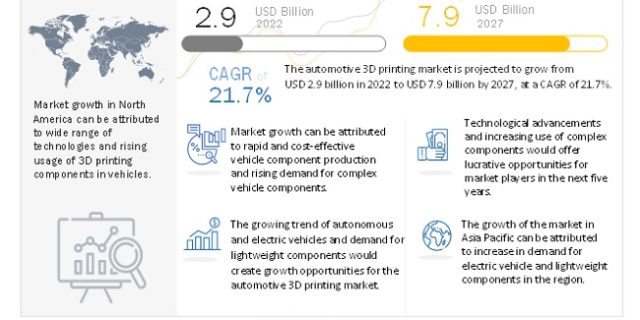
The automotive 3D printing market is projected to grow from USD 2.9 billion in 2022 to USD 7.9 billion by 2027, at a CAGR of 21.7%. The increasing demand for Connected, Autonomous, Shared, Electric (CASE) vehicles, need for low-cost manufacturing, low-volume parts production, complex structured components, and critical engine components that are difficult to produce with conventional manufacturing methods are the factors for the growth of automotive 3D printing.
The ICE vehicle segment is expected to lead the vehicle type segment in usage of 3D printing technology due to the high volume of production.
The ICE vehicle segment is estimated to lead the market during the forecast period. The higher demand for automotive 3D printed components in the economy vehicles and advanced features in the premium vehicles are the driving factor for the ICE vehicle segment to lead the market. The technological advancements in the 3D printing and the increase in vehicle production in the industry are the key factor driving the overall growth of the automotive 3D printing market across all vehicle segments.
3D printing is estimated to be the most used in ICE vehicles because of the high volume of ICE vehicles that are being produced industry. The incorporation of additive manufacturing in ICE vehicles has been increasing rapidly with the wide choice of materials and developing additive manufacturing technologies. Only simple research activities were carried out in the initial stages, but the developments aided automakers in using 3D printing for complex and critical components. The technology helped automotive manufacturers provide a wide range of finishes, textures, and even performance choices to their customers. Leading carmakers are even testing out engine components such as pistons and engine heads with metal 3D printing to incorporate complex cooling channels to extend the efficiency, life, and performance of their vehicles.
Request Free Sample Report @ https://www.marketsandmarkets.com/requestsampleNew.asp?id=250218997
The plastic segment is expected to hold the largest market share in the materials segment in 2022
Plastic is expected to lead the automotive 3D printing market as most of the interior and exterior automotive components are getting replaced with various plastic components. The main reasons for this change are the low cost and ease of manufacturing that are associated with producing plastic components instead of metal components. The plastic 3D printing technologies are being incorporated for their plastic component production by various leading automotive manufacturers. These plastic material components are easily manufactured, offer a good surface finish, and are compatible with many sub-components. The various types of plastic materials used for 3D printing are Acrylonitrile Butadiene Styrene (ABS), nylon, polylactic acid, and others. The applications of plastic printed parts in automotive include dashboard components, housings, brackets, and several other interiors and exterior components.
North America is estimated to be dominate the regional market
North America is estimated to lead the automotive 3D printing market. The North American region includes the US, Canada, and Mexico. The cost reduction in the prototyping and R&D by the leading carmakers in the region is a driving factor for North America to lead in the automotive 3D printing market. Conventionally, the development of physical prototypes is extremely expensive. It can range approximately USD 250,000 to USD 1 Million per vehicle. Usually around 50-70 prototypes are built per development and the automakers spend USD 10 Billion per year on prototypes, cumulatively. These costs can be greatly reduced when incorporating 3D printing technology for these applications. The increasing penetration of advanced and complex components in vehicles produced by the US automotive industry has also fueled the growth of 3D printed components. These purpose-oriented materials which are produced with complex structural shapes cannot be produced using conventional manufacturing techniques. The leading 3D printing manufacturers such as 3D Systems, HP, Stratasys and others supply to most of the leading automakers in the North America such as Ford, General Motors, Tesla, and others. These automakers incorporate the 3D printing for prototyping, R&D and other production activities.
Key Market Players
The automotive 3D printing market is dominated by a few globally established companies such as Stratasys (Israel), 3D Systems (US), EOS (Germany), Arcam AB (Sweden), Renishaw plc. (UK), HP (US), Materialise (Belgium). These companies adopted several strategies to gain traction in the market.
Inquire Before Buying @ https://www.marketsandmarkets.com/Enquiry_Before_BuyingNew.asp?id=250218997
